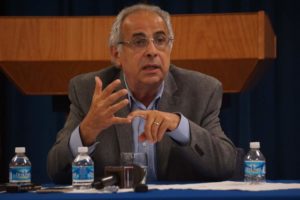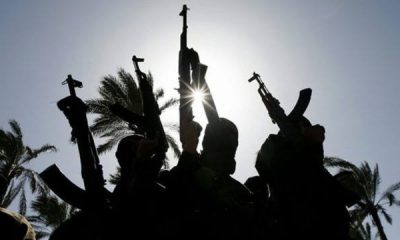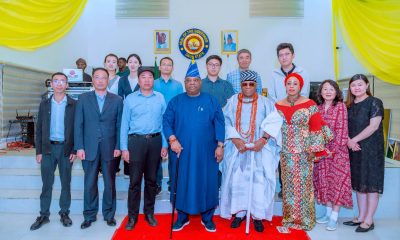Foreign News
Anxieties that throw up Donald Trump’s phenomenon

The Republican Party candidate in the November 9 Presidential Election of the United States (U.S.) Donald Trump has riled many civilised people with his crude language and vulgarity, a character that many said does not reflect the ideals of his party. WALE AJETUNMOBI, who has just returned from Foreign Press Centre (FPC) reporting tour in the U.S., writes on the anxieties which threw up Trump in the U.S. politics.
The politics of the United States (U.S.) has its peculiarities, but it beats the imagination of many Americans how Donald Trump – the Republican Party candidate – rose to become the Grand Old Party’s (GOP’s) nominee for the November 8 presidential contest.
Apart from his vulgarity, which gradually draws many cultured people away from the party, Trump’s choice of words during the GOP primaries and in the ongoing campaign is deemed offensive and unbecoming of a prospective occupant of the U.S. presidency.
“Trump is careless with words and people are worried if he would not bring the country to another war,” says Elizabeth Sherman, an Assistant Professor at the Department of Government of American University in Washington DC.
With the level of sophistication of the U.S. politics, Sherman wondered how the Republican Party threw up Trump, which she described as “unpredictable illiterate”, to raise its flag in the presidential race. Not even decades of his international business engagements could refine his vulgarity, the assistant professor suggested.
For the millennials (youths born between 1980 and 1995), Trump is feared, not because of his vulgarity but for the unpredictability of his character and state of mind.
“America is one of the world’s super power, and occupants of its presidency must be people whose character can be vouched for,” says Carlos Veraza, a second year International Relations student at the American University in Washington DC.
For those wondering about the contradiction which threw up Trump, John Zogby, a renowned public opinion pollster, author and founder of the Zogby Poll, has an answer.
According to the 68-year-old author of Arab America Today: A Demographic Profile of Arab Americans, history of the U.S. is replete with peculiar tension.
“It is usually tension between the “modern” and those “fighting against” the modern,” said Zogby during an interaction with foreign journalists from 23 countries who participated in Foreign Press Centre (FPC) tour organised by the U.S. Department of State.
The renowned American pollster said the contradiction remained a constant theme in the U.S. history, at least every 30 years.
He said Trump was propelled to political limelight by the growing anxieties over the decline of the White middle-class that sees its America falling apart. Among the predominantly white middle-class, the sentiment is mostly financial.
Polls conducted by Zogby showed 37 per cent of American adults, who still working, get jobs that pay less than the previous jobs. Even after wages and salaries have remained static, the polls results showed that many people have not kept up with the cost of living.
“There is a real sense of losing ground of what sociologist would call status anxiety, said Zogby.
He continued: “From 2005 to 2006, three out of four Americans said the American Dream is alive and well. Today, what we are hearing from many people in the White middle-class is that, ‘I am afraid of no longer being middle-class’ and ‘I am very afraid that my children will not be’. This is a real fear. Not only for wages, but because of the transformation of the U.S. economy. America has managed to lose an old manufacturing and information economy, without quickly replacing it with the next economy. So, there is a fear that people are being left behind.”
Zogby said the middle-class being referred to should not be seen in a financial or economic term. “It is a psychological term,” he said, adding: “It is a product of how you feel. And if you feel that you are losing ground, that is how you behave.”
The second source of anxiety among the White middle-class is demography and culture, the pollster said. People, he said, frequently asked: “What happened to my America?”
Zogby said: “There is a report that, by 2042, America would be a nation of the minority of Whites and majority of non-Whites. Many Americans in their communities look out over their windows and see Latinos, Arabs, Muslims and people who are not like them. They ask what happened to America. They gay weddings happening everywhere is another concern. It is hard to come to grips when you are losing ground.”
The third source of the anxiety, Zogby said, is America’s role in the world. He said many people believe the U.S. is supposed to be the unchallenged superpower.
He said: “If you look at how Americans view the proper role of the U.S. in the world, take the age of 50 as your demarcation. Americans of over 50 years of age and older, see everything about the country. Those are the Americans who know the story of the Cold War. They saw good and evil, right and wrong. Those are very easy words to understand.
“Take Americans 50 years of age and less, especially the young people, they see Iraq, Afghanistan, helpless superpower that doesn’t go in to make things better but, can, in fact, make things worse. This is the fundamental battle today. There is no question that the majority is the demographic change in the country and it is those that are 50 years and younger.”
Zogby observed that there is a decline in the number of millennials who turn out to vote in major elections. Demographically, he said there was little the millennials could do to stop the victory of either of the major candidates in the November 8 presidential election – Trump and Senator Hillary Clinton.
The pollster said: “Take a look at the demographics in the last four presidential elections. In 2008, 74 per cent of total votes was from White voters; 9.2 per cent was from Latinos, 12.9 per cent was from African-Americans. And 19.2 per cent of the total voters were between 18-29 years. These figures were almost the same in 2012, where 71 per cent White voted, and Latinos 10.1 per cent, African-American 14.1 per cent, young voter, 19.2 per cent.
“If you look at the congressional elections of 2010 and 2014, you would wonder how the U.S. could have been the same country, because 78-79 per cent of the White voted, six per cent of Latinos, six to 10 per cent of young voters. Republicans won huge majority in both elections. This question is: can young voters turn out to vote? Who will they vote for?”
-

 News5 days ago
News5 days agoGunmen Abduct Retired Customs Officer, Kill Village Chief In Osun–Kwara Border Community
-

 News5 days ago
News5 days agoYuletide: First Lady, Remi Tinubu Distributes 200,000 Each To 250 Elderly Citizens In Osun
-

 News5 days ago
News5 days agoUnity, Love Key To Organisational, Societal Development- Osun Cleric
-

 News4 days ago
News4 days agoChinese Investors Hail Osun Infrastructure Growth As Adeleke, Owa Of Ijeshaland Speak On Industrialization Plans

